Bonsai Nut
Nuttier than your average Nut
Because of the number of questions regarding air-layering on the site, I have attempted to pull together an overview of the science behind air-layering which will directly lead to a list of "best practices" and "frequently asked questions". I am going to try to keep the science really simple (because it gets extremely complicated very quickly) while at the same time ensure that everything I write is scientifically grounded.
Introduction
Air-layering as a way of propagating bonsai material that has some unique advantages. First, the material being layered is a genetic clone of the mother plant. Second, you can often be successful layering mature and large material that cannot be successfully propogated via any other means. Third, layering will often create a ring of fine surface roots that yield an excellent nebari in a short period of time.
Background
All plants sense and interact with their environment. Survival and growth is critically influenced by abiotic factors including water, wind and light. If we understand how a plant senses such factors, and how it translates them into optimal physiological or growth responses, we can better guide the development of our trees. Hormones play an important role in the internal signaling that brings about environment responses, and are keyed in many ways to the environment. Precisely regulated responses to the environment not only allow a plant to survive from day to day, but also determine when a flowering plant will produce a flower, or when a tree will produce roots or buds.
Hormones
Hormones are chemical substances produced in small, often minute quantities in one part of an organism, and when transported to another part, they can bring about physiological or developmental responses. They can both stimulate a response, or inhibit a response. They can work by themselves, or work in concert with other hormones. How they act in a particular instance is influenced by both the hormone(s) and the tissue that receives the message.
In animals, hormones are usually produced at definite sites, usually organs. In plants, hormones are not produced in specialized tissues, but instead, in tissues that also carry out other, usually more obvious functions (like roots, or leaf buds).
There are seven major kinds of plant hormones, but for the purposes of air-layering, we are primarily interested in two: auxin and cytokinin. But we'll get back to these later.
Translocation
Before we start discussing the action of the two hormones mentioned above, we need to review the concept of translocation in plants. Translocation is the movement of materials from leaves and roots to other tissues throughout the plant. Plants create carbohydrates in their leaves via photosynthesis, but other non-photosynthetic parts of plants also require carbohydrates as well as water and nutrients. For this reason, materials are translocated from sources (leaves or roots) to sinks (which could be flowers or nuts or stems). Parts of the plant can be a source of one material (roots absorb water) and a sink of another (roots consume carbohydrates). To facilitate the movement of materials around a plant, there are specialized tissues called the xylem and the phloem. These tissues are made of long continuous strands of specialized cells, and extend all the way from the roots to veins in the leaves. The xylem carries water, nutrients and hormones from the roots all the way up to the leaves. The phloem carries carbohydrates and hormones from the leaves back down the tree all the way to the roots.
In the case of a woody tree, the xylem is the "wood" of the tree, and it consists of older, inactive heartwood, and the part of the xylem that still actively transports materials called the sapwood. The phloem is the living layer just below the bark. Separating the xylem and phloem is the vascular cambium - which generates new layers of xylem in the interior of the tree (making the tree thicker) and also new layers of phloem under the bark. The vascular cambium is the part of the tree trunk that heals damage to the trunk.

Ok so I know this is getting a little complicated, but in simple terms think: sapwood carries water, nutrients and hormones up from the roots, while phloem carries carbohydrates and hormones down from the leaves.
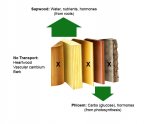
So let's get back to the two hormones we introduced earlier in this article: auxin and cytokinins. These are both "growth" hormones, but they each trigger different responses in the tree based on their presence and interaction. It is important to note that even today (2017) we are just beginning to understand many of the actions of these growth hormones at the cellular and molecular level, and how hormones regulate growth and development.
Auxin
Auxin acts to adapt the plant to its environment in a highly advantageous way. It promotes growth and elongation of cells, and triggers root generation when it is present in certain concentrations. It will migrate away from the presence of light, and will generate stronger growth on the shady side of a plant - which is why plant stems will bend towards light if only lit from one side. Interestingly, the presence of auxin suppresses bud development. Auxins have other impacts on growth and development depending on the presence and concentration of other hormones. These impacts are usually species specific.
Auxin is generated naturally in a plant at the branch tips (apical meristems) in the buds, and secondarily, in the roots. In its natural form it is known as IAA (Indoleacetic Acid). From the tips of the branches and the tips of the roots, auxin will travel towards the base of the trunk.
Synethic auxins such as NAA (naphthalene acetic acid) and IBA (indolebutyric acid) have been discovered that generate a stronger response than IAA. They have many uses in agriculture and horticulture, and can be used to prevent premature fruit drop in trees, hold berries on holly, or induce root formation in cuttings.
It should be noted that while one range of auxins can have a positive effect on plants, too much can have an extremely negative (if not fatal) impact. Synthetic auxins are routinely used in weed control products, where they are applied in higher concentrations than IAA would normally occur in plants. The herbicide 2,4,5-T is a synthetic auxin that was a component of Agent Orange.
Cytokinins
A cytokinin is a type of plant hormone that, in combination with auxin, stimulates cell division and differentiation in plants. Unlike auxin, most cytokinin is produced in the root tips (apical meristems) and transported throughout the plant. Cytokinins, working with other hormones, seem to regulate growth patterns. They promote growth of lateral buds (while auxins suppress them).

(in this graphic, image A shows lateral buds being suppressed by auxin generation in the apical meristem (branch tip). B shows how, when the apical bud is removed (and auxin generation reduced) the plant sprouts lateral buds. However, if an artificial source of auxin is applied, as in image C, bud growth continues to be suppressed.
Conversely, cytokinins inhibit the formation of lateral roots, while auxins promote their formation. It is this balance between cytokinins and auxins that determine whether a plant will favor root development, shoot development, or undifferentiated cells. Lots of plant buds (lots of auxin) and minimal roots (less cytokinin) and the plant will favor root development. Lots of roots (lots of cytokinin) and few buds (less auxin) and the plant will favor shoot development.
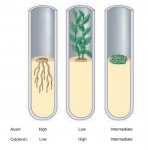
Air-Layering
Now, let's put it all together. Remember what we learned about sapwood - which carries water, nutrients and cytokinin up from the roots. Then we have the phloem - which carries carbs and auxin down from the branch tips. When we air-layer a tree, we are interrupting one of these flows, while keeping the other intact, in order to trigger a specific growth response in our tree.
I will assume people know the process of air-layering, in general. You start by "girdling" the tree, which means that you move a strip of material entirely around the trunk or branch that you wish to layer. You want to ensure three things: First, that you completely sever the phloem, which will cause a break in the flow of carbohydrates and auxins down the trunk/branch. Second, that you completely sever the vascular cambium, since this is the healing layer of the trunk. Third, that you keep the sapwood more or less intact, since you want to continue to provide water and nutrients to the upper part of the air-layer.
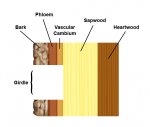
As soon as you girdle the tree, auxins will start to build up at the location of the wound site. Additionally, the vascular cambium will respond to the wound by generating a special type of fast-expanding non-discriminant growth cell that will form a callus, which will physically protect the wound site and try to close it. Finally, the level of auxins below the girdle will start to drop because they are no longer being supplied via the upstream phloem.
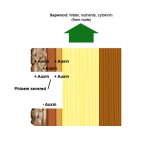
Within a short period of time (as soon as 48-72 hours, if all conditions are optimal) the auxin level above the wound site will reach the level where the balance between auxins and cytokinins shifts decidedly to the auxin side. Because of the elevated presence of auxin in the area, the activity levels of all cell functions are elevated. Cell growth is stimulated, but instead of general non-discriminant growth, the tree is being signaled to generate roots. Meanwhile below the girdle, as auxin levels drop, the auxin/cytokinin balance shifts to the cytokinin side, and the tree is being signaled to produce shoots and develop buds.
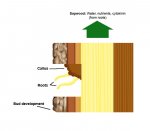
Because the sapwood remains in place, the roots can continue to supply water and nutrients to the upper part of the layer, which is actually in very little distress.
Once an adequate volume of roots has grown at the top of the girdle, the layer may be separated from the parent tree. Usually this is accompanied by two effects - first, the reduction of water, nutrients and cytokinin from the established roots in the parent plant (via the sapwood) will cause a short term drop in shoot development. This will be accompanied by a short term push in root development in the layer due to elevated auxin levels. Once the roots develop to the point that they balance the upper part of the layer, cytokinin levels will rise, auxin / cytokinin balance will be restored, and growth levels will balance in the layer/new tree.
Example 1: Girdling a Chinese cork elm.
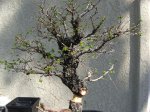
Example 1: Root development at separation of the layer from the parent tree (33 days after girdling).
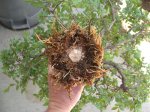
Example 1: Root development one year after separation (after minor trimming and raking). In the case of easy to root species like Chinese elm, the development of roots may be so robust that they extend from the wound site to some distance above the wound - projecting through the bark in places.
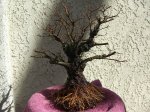
Example 2: Two simultaneous air-layers. The girdle is wrapped with sphagnum moss and is protected by a layer of plastic. The only role of the sphagnum moss is to keep the young roots from drying out. The top of the air-layer bundle is left slightly open so that you can water the moss when it starts to dry out. You can see the new roots under the plastic.
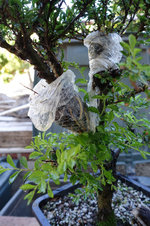
Example 2: Same tree with plastic removed. This air-layer is ready for removal from the parent material. You can see how wide I made the girdle on this material - I had had trouble previously with the tree bridging the girdle with new growth before the air-layer had developed roots.
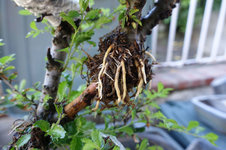
Best Practices
When girdling, make sure you cut all the way through the phloem and the vascular cambium to the sapwood. It is better to even scrape into the sapwood than to fall short and leave strips of vascular cambium behind. Even a small layer of vascular cambium cells can quickly heal into a bridge between upper and lower parts of the girdle, restoring flow to the phloem and preventing the accumulation of auxin above the girdle.
If you are in a sunny location, cover your air-layer location with aluminum foil. Because auxins migrate away from light, there is a possibility that allowing light to shine on one side of the girdle may suppress root development on that side, or that young roots might get heated or otherwise compromised by the sun. You can use plastic wrap to keep in the water, and wrap an aluminum foil "shield" around your layer like a ball - keeping a small opening at the top so you can water and keep your air-layer bundle wet.
FAQ
Q: Is there a best time to air-layer?
A: Yes. The best time to air-layer is during late spring / early summer when new growth has hardened but while the tree is still in growth mode.
Q: Should I defoliate / prune a branch before air-layering it?
A: No. Because auxins are generated at the tips of the branches, it is best to leave as many apical buds as possible.
Q: Should I use artificial auxin on the upper edge of the girdle?
A: Usually not required, as long as the airlayer has a lot of healthy growth (and buds) above the girdle. Will not harm your airlayer attempt, regardless, as long as you don't use too strong of an auxin concentration.
Q: What concentration of artificial auxin should I use?
A: Depends on the species of the tree. I recommend further research, or reference to Dirr and Hueser's The Reference Manual of Woody Plant Propagation.
Q: Is it better to use sphagnum moss or bonsai mix in the air-layer?
A: Whichever you personally prefer. The function of the propagation mix in the air-layer bundle is simply to prevent the new roots from drying out. It serves no other functional purpose, since the water and nutrient needs of the air-layer are still being met by the translocation flow in the sapwood.
Q: Can I do more than one air-layer on a tree at a time?
A: Yes, but you should only try to air-layer a branch that has an uninterrupted path to terminal buds. In other words, you can air-layer two branches next to each other, but do not try two air-layers on the same branch (directly above and below each other).
Q: After I separate the air-layer, should I prune the branches?
A: It is better to leave them unpruned, since the branch tips are providing auxin to continue to develop the new roots. If you need to protect the foliage until the new roots increase their capacity to provide adequate water, you can use a humidity tent over the tree. The sign that it is "safe" to prune the tree is when you see it start to pop new buds and push new growth.
Introduction
Air-layering as a way of propagating bonsai material that has some unique advantages. First, the material being layered is a genetic clone of the mother plant. Second, you can often be successful layering mature and large material that cannot be successfully propogated via any other means. Third, layering will often create a ring of fine surface roots that yield an excellent nebari in a short period of time.
Background
All plants sense and interact with their environment. Survival and growth is critically influenced by abiotic factors including water, wind and light. If we understand how a plant senses such factors, and how it translates them into optimal physiological or growth responses, we can better guide the development of our trees. Hormones play an important role in the internal signaling that brings about environment responses, and are keyed in many ways to the environment. Precisely regulated responses to the environment not only allow a plant to survive from day to day, but also determine when a flowering plant will produce a flower, or when a tree will produce roots or buds.
Hormones
Hormones are chemical substances produced in small, often minute quantities in one part of an organism, and when transported to another part, they can bring about physiological or developmental responses. They can both stimulate a response, or inhibit a response. They can work by themselves, or work in concert with other hormones. How they act in a particular instance is influenced by both the hormone(s) and the tissue that receives the message.
In animals, hormones are usually produced at definite sites, usually organs. In plants, hormones are not produced in specialized tissues, but instead, in tissues that also carry out other, usually more obvious functions (like roots, or leaf buds).
There are seven major kinds of plant hormones, but for the purposes of air-layering, we are primarily interested in two: auxin and cytokinin. But we'll get back to these later.
Translocation
Before we start discussing the action of the two hormones mentioned above, we need to review the concept of translocation in plants. Translocation is the movement of materials from leaves and roots to other tissues throughout the plant. Plants create carbohydrates in their leaves via photosynthesis, but other non-photosynthetic parts of plants also require carbohydrates as well as water and nutrients. For this reason, materials are translocated from sources (leaves or roots) to sinks (which could be flowers or nuts or stems). Parts of the plant can be a source of one material (roots absorb water) and a sink of another (roots consume carbohydrates). To facilitate the movement of materials around a plant, there are specialized tissues called the xylem and the phloem. These tissues are made of long continuous strands of specialized cells, and extend all the way from the roots to veins in the leaves. The xylem carries water, nutrients and hormones from the roots all the way up to the leaves. The phloem carries carbohydrates and hormones from the leaves back down the tree all the way to the roots.
In the case of a woody tree, the xylem is the "wood" of the tree, and it consists of older, inactive heartwood, and the part of the xylem that still actively transports materials called the sapwood. The phloem is the living layer just below the bark. Separating the xylem and phloem is the vascular cambium - which generates new layers of xylem in the interior of the tree (making the tree thicker) and also new layers of phloem under the bark. The vascular cambium is the part of the tree trunk that heals damage to the trunk.

Ok so I know this is getting a little complicated, but in simple terms think: sapwood carries water, nutrients and hormones up from the roots, while phloem carries carbohydrates and hormones down from the leaves.

So let's get back to the two hormones we introduced earlier in this article: auxin and cytokinins. These are both "growth" hormones, but they each trigger different responses in the tree based on their presence and interaction. It is important to note that even today (2017) we are just beginning to understand many of the actions of these growth hormones at the cellular and molecular level, and how hormones regulate growth and development.
Auxin
Auxin acts to adapt the plant to its environment in a highly advantageous way. It promotes growth and elongation of cells, and triggers root generation when it is present in certain concentrations. It will migrate away from the presence of light, and will generate stronger growth on the shady side of a plant - which is why plant stems will bend towards light if only lit from one side. Interestingly, the presence of auxin suppresses bud development. Auxins have other impacts on growth and development depending on the presence and concentration of other hormones. These impacts are usually species specific.
Auxin is generated naturally in a plant at the branch tips (apical meristems) in the buds, and secondarily, in the roots. In its natural form it is known as IAA (Indoleacetic Acid). From the tips of the branches and the tips of the roots, auxin will travel towards the base of the trunk.
Synethic auxins such as NAA (naphthalene acetic acid) and IBA (indolebutyric acid) have been discovered that generate a stronger response than IAA. They have many uses in agriculture and horticulture, and can be used to prevent premature fruit drop in trees, hold berries on holly, or induce root formation in cuttings.
It should be noted that while one range of auxins can have a positive effect on plants, too much can have an extremely negative (if not fatal) impact. Synthetic auxins are routinely used in weed control products, where they are applied in higher concentrations than IAA would normally occur in plants. The herbicide 2,4,5-T is a synthetic auxin that was a component of Agent Orange.
Cytokinins
A cytokinin is a type of plant hormone that, in combination with auxin, stimulates cell division and differentiation in plants. Unlike auxin, most cytokinin is produced in the root tips (apical meristems) and transported throughout the plant. Cytokinins, working with other hormones, seem to regulate growth patterns. They promote growth of lateral buds (while auxins suppress them).

(in this graphic, image A shows lateral buds being suppressed by auxin generation in the apical meristem (branch tip). B shows how, when the apical bud is removed (and auxin generation reduced) the plant sprouts lateral buds. However, if an artificial source of auxin is applied, as in image C, bud growth continues to be suppressed.
Conversely, cytokinins inhibit the formation of lateral roots, while auxins promote their formation. It is this balance between cytokinins and auxins that determine whether a plant will favor root development, shoot development, or undifferentiated cells. Lots of plant buds (lots of auxin) and minimal roots (less cytokinin) and the plant will favor root development. Lots of roots (lots of cytokinin) and few buds (less auxin) and the plant will favor shoot development.

Air-Layering
Now, let's put it all together. Remember what we learned about sapwood - which carries water, nutrients and cytokinin up from the roots. Then we have the phloem - which carries carbs and auxin down from the branch tips. When we air-layer a tree, we are interrupting one of these flows, while keeping the other intact, in order to trigger a specific growth response in our tree.
I will assume people know the process of air-layering, in general. You start by "girdling" the tree, which means that you move a strip of material entirely around the trunk or branch that you wish to layer. You want to ensure three things: First, that you completely sever the phloem, which will cause a break in the flow of carbohydrates and auxins down the trunk/branch. Second, that you completely sever the vascular cambium, since this is the healing layer of the trunk. Third, that you keep the sapwood more or less intact, since you want to continue to provide water and nutrients to the upper part of the air-layer.

As soon as you girdle the tree, auxins will start to build up at the location of the wound site. Additionally, the vascular cambium will respond to the wound by generating a special type of fast-expanding non-discriminant growth cell that will form a callus, which will physically protect the wound site and try to close it. Finally, the level of auxins below the girdle will start to drop because they are no longer being supplied via the upstream phloem.

Within a short period of time (as soon as 48-72 hours, if all conditions are optimal) the auxin level above the wound site will reach the level where the balance between auxins and cytokinins shifts decidedly to the auxin side. Because of the elevated presence of auxin in the area, the activity levels of all cell functions are elevated. Cell growth is stimulated, but instead of general non-discriminant growth, the tree is being signaled to generate roots. Meanwhile below the girdle, as auxin levels drop, the auxin/cytokinin balance shifts to the cytokinin side, and the tree is being signaled to produce shoots and develop buds.

Because the sapwood remains in place, the roots can continue to supply water and nutrients to the upper part of the layer, which is actually in very little distress.
Once an adequate volume of roots has grown at the top of the girdle, the layer may be separated from the parent tree. Usually this is accompanied by two effects - first, the reduction of water, nutrients and cytokinin from the established roots in the parent plant (via the sapwood) will cause a short term drop in shoot development. This will be accompanied by a short term push in root development in the layer due to elevated auxin levels. Once the roots develop to the point that they balance the upper part of the layer, cytokinin levels will rise, auxin / cytokinin balance will be restored, and growth levels will balance in the layer/new tree.
Example 1: Girdling a Chinese cork elm.

Example 1: Root development at separation of the layer from the parent tree (33 days after girdling).

Example 1: Root development one year after separation (after minor trimming and raking). In the case of easy to root species like Chinese elm, the development of roots may be so robust that they extend from the wound site to some distance above the wound - projecting through the bark in places.

Example 2: Two simultaneous air-layers. The girdle is wrapped with sphagnum moss and is protected by a layer of plastic. The only role of the sphagnum moss is to keep the young roots from drying out. The top of the air-layer bundle is left slightly open so that you can water the moss when it starts to dry out. You can see the new roots under the plastic.

Example 2: Same tree with plastic removed. This air-layer is ready for removal from the parent material. You can see how wide I made the girdle on this material - I had had trouble previously with the tree bridging the girdle with new growth before the air-layer had developed roots.

Best Practices
When girdling, make sure you cut all the way through the phloem and the vascular cambium to the sapwood. It is better to even scrape into the sapwood than to fall short and leave strips of vascular cambium behind. Even a small layer of vascular cambium cells can quickly heal into a bridge between upper and lower parts of the girdle, restoring flow to the phloem and preventing the accumulation of auxin above the girdle.
If you are in a sunny location, cover your air-layer location with aluminum foil. Because auxins migrate away from light, there is a possibility that allowing light to shine on one side of the girdle may suppress root development on that side, or that young roots might get heated or otherwise compromised by the sun. You can use plastic wrap to keep in the water, and wrap an aluminum foil "shield" around your layer like a ball - keeping a small opening at the top so you can water and keep your air-layer bundle wet.
FAQ
Q: Is there a best time to air-layer?
A: Yes. The best time to air-layer is during late spring / early summer when new growth has hardened but while the tree is still in growth mode.
Q: Should I defoliate / prune a branch before air-layering it?
A: No. Because auxins are generated at the tips of the branches, it is best to leave as many apical buds as possible.
Q: Should I use artificial auxin on the upper edge of the girdle?
A: Usually not required, as long as the airlayer has a lot of healthy growth (and buds) above the girdle. Will not harm your airlayer attempt, regardless, as long as you don't use too strong of an auxin concentration.
Q: What concentration of artificial auxin should I use?
A: Depends on the species of the tree. I recommend further research, or reference to Dirr and Hueser's The Reference Manual of Woody Plant Propagation.
Q: Is it better to use sphagnum moss or bonsai mix in the air-layer?
A: Whichever you personally prefer. The function of the propagation mix in the air-layer bundle is simply to prevent the new roots from drying out. It serves no other functional purpose, since the water and nutrient needs of the air-layer are still being met by the translocation flow in the sapwood.
Q: Can I do more than one air-layer on a tree at a time?
A: Yes, but you should only try to air-layer a branch that has an uninterrupted path to terminal buds. In other words, you can air-layer two branches next to each other, but do not try two air-layers on the same branch (directly above and below each other).
Q: After I separate the air-layer, should I prune the branches?
A: It is better to leave them unpruned, since the branch tips are providing auxin to continue to develop the new roots. If you need to protect the foliage until the new roots increase their capacity to provide adequate water, you can use a humidity tent over the tree. The sign that it is "safe" to prune the tree is when you see it start to pop new buds and push new growth.
Last edited:

